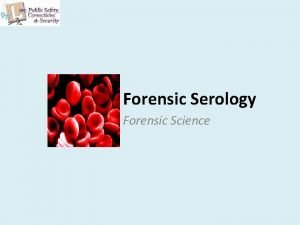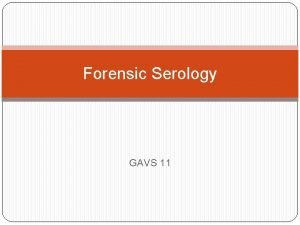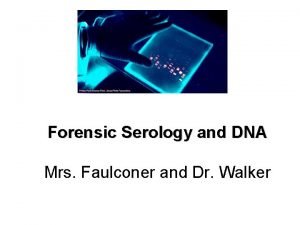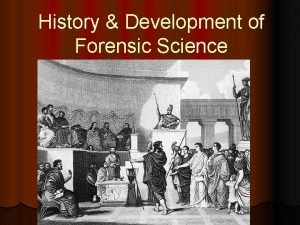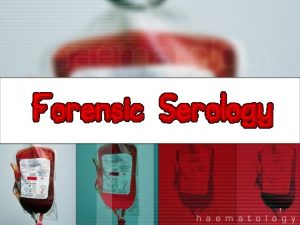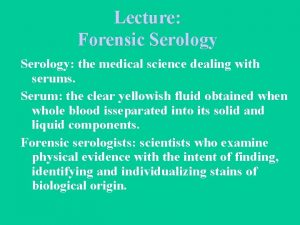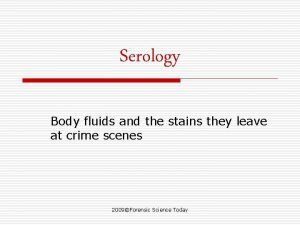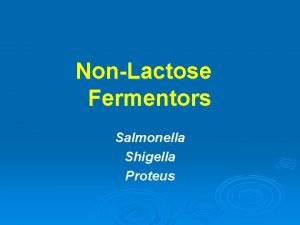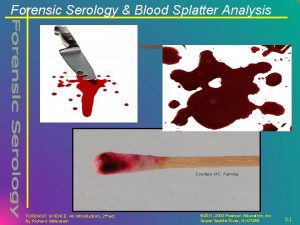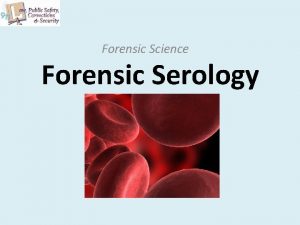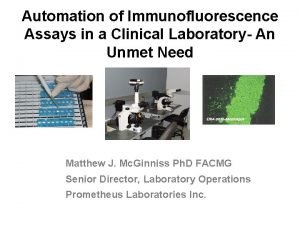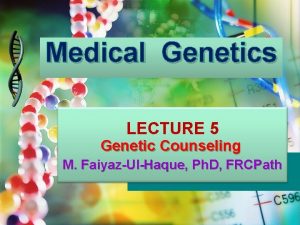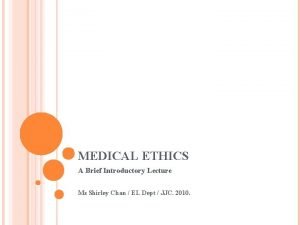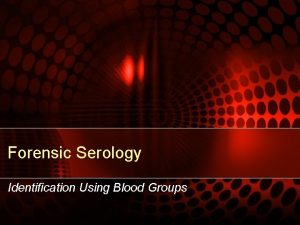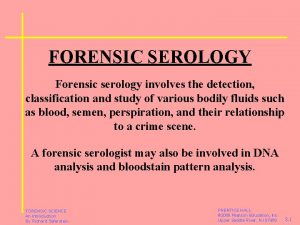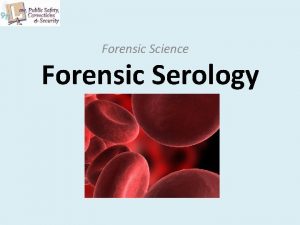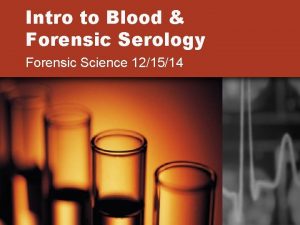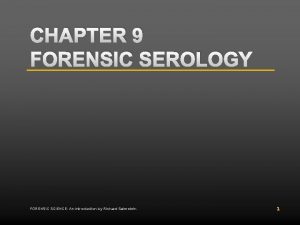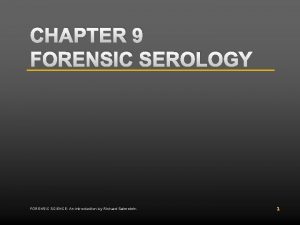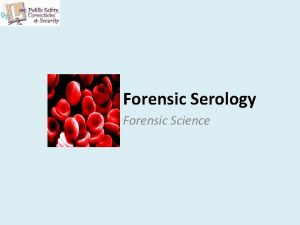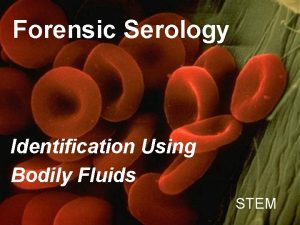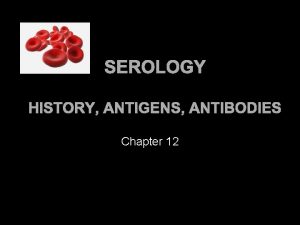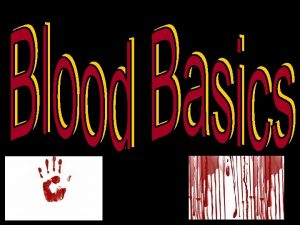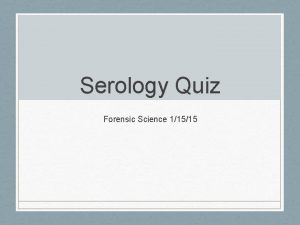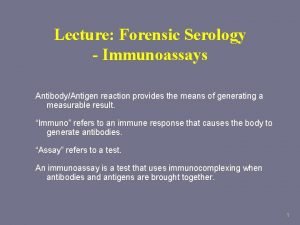Lecture Forensic Serology the medical science dealing with























- Slides: 23

Lecture: Forensic Serology: the medical science dealing with serums. Serum: the clear yellowish fluid obtained when whole blood isseparated into its solid and liquid components. Forensic serologists: scientists who examine physical evidence with the intent of finding, identifying and individualizing stains of biological origin.

Definitions LBlood: suspended in the blood are solid materials, including red blood cells (erythrocytes), white blood cells (leukocytes) and platelets. LAntigens: chemical structures attached to the surfaces of red blood cells. LAntibodies: proteins floating in the serum that exist because people have allergies or may have come in contact with a common disease (TB, smallpox, and hepatitis are common antibodies).

Blood Typing & Distribution Blood type Antigens on Red cells Antibodies in Serum A A Anti-B B B Anti-A AB AB Neither anti-A or anti-B O Neither anti-A or anti-B Both anti-A and anti-B O A B AB 43 -45% 40 -42% 10 -12% 3 -5% O+ 39% O- 6% A+ 35% A- 5% B+ 8% B- 2% AB+ 4% AB- 1%


Blood Enzymes and Proteins L Enzymes: proteins that have important functions in regulating the body’s chemistry. L Enzymes have the characteristic of existing in different forms (polymorphic) and can be separated into protein components called iso-enzymes. L A common polymorphism is Hb, which causes sickle-cell anemia. L Iso-enzymes can be separated by electrophoresis. L Forensic serologists have studied these iso-enzymes with the goal of being able to individualize blood samples found at crime scenes. L While there are many iso-enzymes in blood, only those that survive the drying and aging process are useful to the forensic serologist.

Iso-enzymes and Probability L Each of these protein and enzyme variants, as well as all blood subtypes, have known distributions in a population. L It's therefore a simple matter to calculate probability estimates that border on individualized blood typing. L Probability is defined as the frequency of an event occurring. L If there are several event that may occur, the overall probability will be the product of these probabilities. L Probability is usually expressed in per cent (i. e. , 25%), while the frequency of an event is expressed as a decimal value (i. e. , 0. 25) L At a crime scene, a blood sample and the suspect’s blood had the following characteristics: A blood (42%), basic subtype A 2 (25%), protein AK (15%) and enzyme PGM 2 (6. 0%). What is the frequency of occurrence of these blood characteristics in the general population? L Answer: 0. 00094 (0. 42 X 0. 25 X 0. 15 X 0. 06) or 0. 094% probability!

BLOODSTAIN CHARACTERIZATION L Bloodstain analysis traditionally follows the following steps: L Is the stain blood? L Is the stain animal or human blood? L If human blood, what type? L Can the sex, age, and race of the source of blood be determined? LIs the stain blood? LThe benzidine test was long used until replaced by the Kastle. Meyer test. LBoth tests are color tests based on the observation that hemoglobin will oxidize several classes of organic compounds. LWhile Kastle-Meyer is not a specific test for blood, the other materials that will cause a pink color change are unlikely to be found at crime scenes.

BLOODSTAIN CHARACTERIZATION LIs the stain blood? LAnother test used is a Hemastix® strip, which will turn green in the presence of blood. LLuminol is an important presumtive identification test for blood. The iron in hemoglobin reacts with the luminol and causes the emission of light (luminescence).

BLOODSTAIN CHARACTERIZATION LIs the stain animal or human blood? LTo answer Question 2, forensic serologists use antiserum tests. LThe standard test is called the precipitin test LThis involves forming antibodies to human blood in an animal. LThe animal serum thus treated will cause a precipitate to form when reacted with human blood.

Blood Stain Patterns LInformation Obtained: LOrigin of bloodstains LDistance between point of impact and origin LType and direction of impact LObject/weapon used LMinimum number of blows LPosition of victim, offender, and objects LMovement by victim or offender at scene LSupport/contradict witness statements LIndicate staged/secondary scenes

Blood Stain Patterns LCast-off Stains

Blood Stain Patterns LDrip patterns

Blood Stain Patterns LSwipe

Blood Stain Patterns LWipe

Blood Stain Patterns LEffects of Surface Texture LHorizontal drop creates circular pattern LForces of surface tension LRougher surface = greater distortion

Blood Stain Patterns LImpact Angles LDefined as the internal angle at which blood strikes a target surface LGreater angle = greater elongation LDetermine direction of travel

Blood Stain Patterns LCalculating Impact Angle LDetermine L/W ratio LDetermine W/L ratio LUse calculator or standard curve

Blood Stain Patterns LPoint of Origin




Principles of Heredity L Transmission of Traits L Accomplished by genes, which is the basic unit of heridity. L Genes are on chromosomes (46 in 23 pairs). L The human egg and human sperm contain 23 chromosomes, which combine during fertilization. L A female has XX chromosome, and male has XY chromosome. L Transmission of Traits L Genes and chromosomes come in pairs. L The position of a gene on the chromosome is called the locus. L Alleles are alternative forms of genes that influence an inherited characteristic. L An example of allele genes is the A-B-O blood type system.

Principles of Heridity L Transmission of Traits L A-B-O blood types: LWhen a gene is made of two similar genes, they are said to be homozygous. Examples include AA or BB. LIf the gene is made up of two different genes, it is said to be heterozygous. An example would be AB. LA and B genes are dominant, while O genes are recessive. L A pair of A-B-O allele genes together are the genotype of an individual. L The phenotype of an individual is the outward characteristic of the individual. L There is no lab test to determine a person’s A-B-O genotype. L If the genotypes of both parents are known, a Punnet square may be constructed to determine potential genotype of offspring.
 Cins ve tür arasındaki fark
Cins ve tür arasındaki fark Father of forensic toxicology
Father of forensic toxicology Arterial spray definition forensics
Arterial spray definition forensics Father of forensic serology
Father of forensic serology Father of forensic serology
Father of forensic serology Define forensic serology
Define forensic serology Father of forensic serology
Father of forensic serology Forensic serology definition
Forensic serology definition Thomas mocker and thomas stewart
Thomas mocker and thomas stewart Who is this
Who is this It is a genre of speculative fiction dealing
It is a genre of speculative fiction dealing Forensic psychology lecture
Forensic psychology lecture Serology
Serology Forensic science blood basics notes
Forensic science blood basics notes Serology book
Serology book Serology
Serology Proteus non lactose fermenter
Proteus non lactose fermenter Serology
Serology Lines of convergence definition forensics
Lines of convergence definition forensics Prometheus celiac serology
Prometheus celiac serology 01:640:244 lecture notes - lecture 15: plat, idah, farad
01:640:244 lecture notes - lecture 15: plat, idah, farad My favourite science
My favourite science Medical genetics lecture
Medical genetics lecture Medical ethics lecture
Medical ethics lecture
